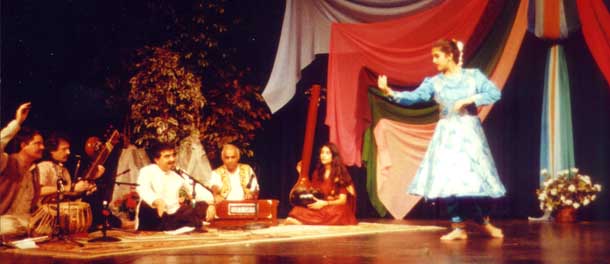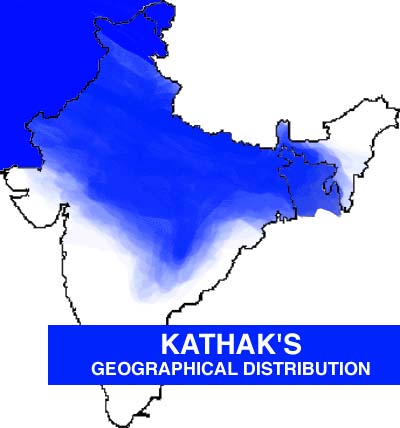A Classical Dance of North India

Kathak is the major classical dance form of northern India. The word kathak means “to tell a story”. It is derived from the dance dramas of ancient India. When the patronage shifted from the temples to the royal court, there was a change in the overall emphasis. The emphasis shifted from the telling of religious stories to one of entertainment. Today, the story-telling aspect has been downgraded and the dance is primarily an abstract exploration of rhythm and movement.
Kathak was primarily associated with an institution known as the tawaif. This is a much misunderstood institution of female entertainers, very much like the geisha tradition of Japan. It was a profession which demanded the highest standards of training, intelligence, and most important, civility. It is said that it was common for royalty to send their children to the tawaifs for instruction in etiquette. Unfortunately, when the British consolidated their hold over India during the Victorian era, this great institution was branded as mere prostitution and was outlawed. This set the art-form of kathak into a downward spiral that was not reversed until Independence when there was a reawakening in interest in traditional Indian art-forms.

Gharanas of Kathak
There are three main gharanas, or schools of kathak. These schools are named according to the geographical area in which they developed. These are the Jaipur, Lucknow, and the Benares gharanas. Each has a slight difference in interpretation and repertoire.
Musical Instruments Used To Accompany Kathak
Any of the instruments associated with north Indian classical music may be found in the accompaniment of the kathak. The most common percussive instruments are the tabla and the pakhawaj. The tanpura is the ubiquitous instrument used to supply the drone, but surmandal is also commonly found as a secondary drone instrument. Melodically, the sarangi was the preferred instrument to supply the lahara, or other melodic accompaniment. However, today the harmonium is usually found in place of the sarangi. Small bells on the feet of the dancer, known as ghungharu, have special association with kathak, as they do for almost all classical dance. Other instruments which may be found on occasion are the bansuri, dilruba, esraj, santur, sarod, or sitar.
Selected Videos
Other Sites of Interest
On Filming Classical Indian Dance
The Limits Of Orientalism: Classical Indian Dance And The Discourse Of Heritage
From interculturalism to historicism: reflections on classical Indian dance (2000/1)
Classical Indian Dance in Literature and the Arts Kapila Vatsyayan (Book Review)
From: Bodies that Matter: on the Discursive Limits of ‘sex'
The Theory and Technique of Classical Indian Dancing
From Interculturalism to Historicism: Reflections on Classical Indian Dance
Classical Indian Dance and Women’s Status
Bharata Natyam: A Classical Indian Dance in Transition
